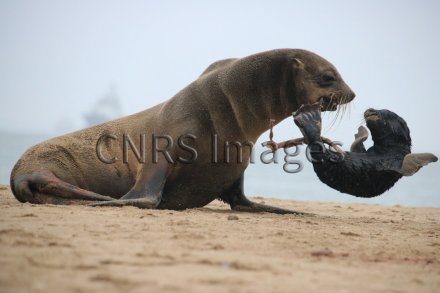Production year
2021

© Isabelle CHARRIER / NeuroPSI / CNRS Images
20220122_0004
This Cape fur seal has just given birth: the pink umbilical cord of her pup is still visible. She moves her baby by throwing it in the air in order to keep it away from other females in the colony, which might become very aggressive towards this little stranger if he came near them. A rather harsh, but necessary, start to life! The species forms huge, dense colonies in Namibia, where females give birth to a single pup that they nurse for 10 to 11 months. Throughout the lactation period, the young seal is exposed to long, repeated absences of its mother, who heads out to sea to feed. To be sure that their pups recognise them when they return to the noisy colony, the females wait until their offspring has fully learned to identify their voice before setting off for the first time. This image is one of the winners of the 2022 La preuve par l’image (LPPI) photography competition.
The use of media visible on the CNRS Images Platform can be granted on request. Any reproduction or representation is forbidden without prior authorization from CNRS Images (except for resources under Creative Commons license).
No modification of an image may be made without the prior consent of CNRS Images.
No use of an image for advertising purposes or distribution to a third party may be made without the prior agreement of CNRS Images.
For more information, please consult our general conditions
2021
Our work is guided by the way scientists question the world around them and we translate their research into images to help people to understand the world better and to awaken their curiosity and wonderment.